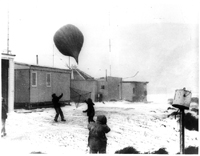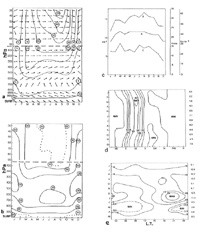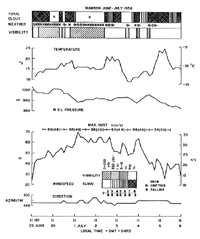


Antarctic Operational Meteorology
Abstract
Introduction
The Past
The Present
The Future
Acknowledgements
References
Index
Search
Help
Contact us

When ANARE was established such regular upper air observations were put into effect at Macquarie and Heard Islands (Figure 2) and the data were sent by radio to the Bureau of Meteorology in Melbourne to form the basis for attempts at real time analysis of the weather patterns over the Southern Ocean using frontal techniques (Gibbs et al. 1952). To this end, an "Air Mass and Frontal Analysis Section" (AMFA) had previously been established at the Bureau's Head Office in Melbourne to enable a group of experienced meteorologists to maintain a constant and consistent program to try to understand the evolution of Australian weather systems including consideration of the new data from the Southern Ocean islands in the sector extending from Heard Is to Macquarie Is and New Zealand. This work led to the development of techniques to analyse the patterns of the upper winds, time cross sections of the atmosphere at particular locations and attempts to track and predict the movement of disturbances passing generally eastward from Heard, Kerguelen Amsterdam and Macquarie Islands and skirting the southern coasts of Australia. AMFA was thus the predecessor of the later relevant groups established by the Bureau which were successively titled the Central Analysis Office (CAO) Southern Hemisphere Analysis Centre (SHAC) and the National Meteorological Analysis Centre (NMAC). Today this group is known as the National Meteorological Centre (NMC).

With the establishment of Mawson in 1954 (albeit with the loss of the Heard Is observations though with observations continuing by the French expedition at Kerguelen) a new window was opened with observations from the fringe of continental Antarctica (Loewe 1956, Shaw 1957, Hannan and Dingle 1958, Streten 1961, Weller 1969). However, in the earliest years the isolated Mawson observations were primarily of interest for studies of the in-situ conditions (in particular, the low level wind structure and the characteristics of blizzards rather than how they fitted into the broad pattern of Southern Hemisphere meteorology, the latter requiring observations from additional locations on the Antarctic continent. The initial studies of the local climate at Mawson (as with other individual locations in Antarctica) have been further documented over the years and constitute a useful benchmark data site for the monitoring of global climate. Figures 3 and 4 indicate some basic characteristics of the Mawson wind and severe weather regime as an example of the longer term records from Antarctic stations. The total observational record from ANARE stations and field sites was systematically published over many years and is now consolidated into a readily accessible, quality controlled computer archive held by the Bureau's National Climate Centre.


The next major step in the resolution of the big picture of Southern Ocean meteorological processes came with the International Geophysical Year (IGY) of 1957–58 when a substantial network of stations was set up in Antarctica to provide extensive geophysical data and, in particular, surface and upper air meteorological observations around the continent and at the US Amundsen-Scott base at the South Pole and at the USSR base at Vostok in the interior. These stations included Davis and the US base at Wilkes (which was operated by Australia from 1959 to 1969 when it was replaced by the new Australian built station, Casey). The IGY Antarctic network data together with the observations from the circumpolar Southern Ocean islands were now available for the first time and were assembled on an operational basis at the US station Little America in the Ross Sea where an "Antarctic Weather Central" was established and a team of international meteorologists including K. Morley from Australia attempted a full hemisphere analysis. This work led to the publication of extensive international studies of southern hemisphere circulation eg. by Astapenko (1964), van Loon (1965, 1967) and Taljaard (1972). A more detailed Australian perspective of early Southern Hemisphere meteorological analysis and the contributions of many Australian synoptic meteorologists including R. H. Clarke, W. J. Gibbs, A. K. Hannay, J. C. Langford, H. M. Treloar, U. Radok and P. J. Shaw is given elsewhere (Streten 1980a).
Following the IGY a major international conference on Antarctic meteorology was held in Melbourne (Bureau of Meteorology 1960) and a continuing international analysis program was established in Melbourne at the International Antarctic Analysis Centre (IAAC) (Gibbs 1960a 1960b. This Centre operated from 1959–1966 (from 1966 to 1969 being known as the International Antarctic Meteorological Research Centre (IAMRC) under the leadership of H. R. Phillpot of the Australian Bureau of Meteorology. After 1967 its operational analysis function was taken over by the Bureau's Southern Hemisphere Analysis Centre (SHAC) and finally by the National Meteorological Centre (NMC). During their operation IAAC and IAMRC examined many aspects of Antarctic meteorology including mass and heat balance (Berson 1966) stratospheric warming (Phillpot 1969), surface temperature inversions (Phillpot and Zillman 1970) and broadscale synoptic climatology (Phillpot 1964 and 1968).
Organisations in Australian Science at Work - Air Mass and Frontal Analysis Section (AMFA); Central Analysis Office (CAO); International Antarctic Analysis Centre; International Antarctic Meteorological Research Centre; National Meteorological Analysis Centre; National Meteorological Centre (NMC); Southern Hemisphere Analysis Centre
People in Bright Sparcs - Clarke, Reginald Henry; Hannay, Alexander Keith (Keith); Phillpot, Henry Robert; Shaw, Peter; Streten, Neil Anthony; Treloar, Harry Mayne
 |
Bureau of Meteorology |  |
© Online Edition Australian Science and Technology Heritage Centre and Bureau of Meteorology 2001
Published by Australian Science and Technology Heritage Centre, using the Web Academic Resource Publisher
http://www.austehc.unimelb.edu.au/fam/1586.html